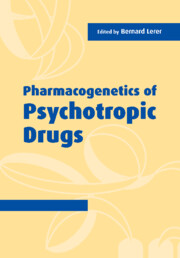Book contents
- Frontmatter
- Contents
- List of contributors
- Part I Introduction
- Part II Clinical background and research design
- Part III Molecular background
- Part IV Pharmacokinetics
- Part V Specific psychotropic drugs and disorders
- 10 Clozapine response and genetic variation in neurotransmitter receptor targets
- 11 Genetic factors underlying drug-induced tardive dyskinesia
- 12 Functional gene-linked polymorphic regions in pharmacogenetics
- 13 Alternative phenotypes and the pharmacogenetics of mood and anxiety disorders
- 14 Pharmacogenetics of anxiolytic drugs and the GABA–benzodiazepine receptor complex
- 15 Genetic factors and long-term prophylaxis in bipolar disorder
- 16 Genetic influences on responsiveness to anticonvulsant drugs
- 17 Apolipoprotein E as a marker in the treatment of Alzheimer's disease
- 18 Genetic variation and drug dependence risk factors
- Part VI Pharmacogenetics and brain imaging
- Part VII Industry perspectives
- Index
13 - Alternative phenotypes and the pharmacogenetics of mood and anxiety disorders
from Part V - Specific psychotropic drugs and disorders
Published online by Cambridge University Press: 20 August 2009
- Frontmatter
- Contents
- List of contributors
- Part I Introduction
- Part II Clinical background and research design
- Part III Molecular background
- Part IV Pharmacokinetics
- Part V Specific psychotropic drugs and disorders
- 10 Clozapine response and genetic variation in neurotransmitter receptor targets
- 11 Genetic factors underlying drug-induced tardive dyskinesia
- 12 Functional gene-linked polymorphic regions in pharmacogenetics
- 13 Alternative phenotypes and the pharmacogenetics of mood and anxiety disorders
- 14 Pharmacogenetics of anxiolytic drugs and the GABA–benzodiazepine receptor complex
- 15 Genetic factors and long-term prophylaxis in bipolar disorder
- 16 Genetic influences on responsiveness to anticonvulsant drugs
- 17 Apolipoprotein E as a marker in the treatment of Alzheimer's disease
- 18 Genetic variation and drug dependence risk factors
- Part VI Pharmacogenetics and brain imaging
- Part VII Industry perspectives
- Index
Summary
OVERVIEW
The biological mechanisms of action of the main classes of antidepressant compound involve the serotonin (5-HT) system. Consequently, genes of this system have been considered ideal candidates in pharmacogenetic studies of the antidepressant response. There are critical methodological issues created by the complexity of the definition of the phenotypes (i.e., categorical versus dimensional), the involvement of nongenetic factors in determining the clinical effect of antidepressants, and the different genetic strategies available to detect genetic susceptibility in complex traits (e.g., family-based association studies, transmission disequilibrium test for qualitative and quantitative traits). In this chapter, we present and discuss the most recent findings on genetic predictors of the response to antidepressants in mood and anxiety disorders. The need for a more homogeneous phenotype definition (e.g., including phenotypes related to the diagnosis such as rapid cycling course, psychotic symptoms, atypical features) is pointed out. We also propose and discuss the role of alternative phenotypes (side effects or non-desirable reactions) in pharmacogenetic studies focused on the prediction of the clinical effect of antidepressants. As an example, the phenomenon of antidepressant-induced mania, as an abnormal response to antidepressants, is described. The most recent data on the role of candidate genes (particularly for the 5-HT system, e.g., 5-HTT, 5HT1Dβ, 5HT2A) in contributing to the risk of developing this phenotype are presented and discussed.
Keywords
- Type
- Chapter
- Information
- Pharmacogenetics of Psychotropic Drugs , pp. 283 - 299Publisher: Cambridge University PressPrint publication year: 2002



